Case Study: IFFCO UAE - Credit Policy Impact on FMCG Sales Performance
VerifiedAdded on 2020/05/16
|20
|5480
|190
Case Study
AI Summary
This case study examines the impact of credit policy on the sales performance of IFFCO, a major player in the FMCG industry in the UAE. It explores the importance of credit policy, its objectives, and the role of credit insurance in recoveries. The study analyzes sales performance implications, discussing both positive and negative impacts of credit policy, and addresses the frequency of policy reviews. It covers factors for appraising credit applications, methods for encouraging prompt payments, accounts receivable management techniques, potential challenges, and strategies for effective management. The case study concludes with ways to enhance IFFCO's credit policy and provides recommendations based on the analysis of the UAE's economic and market dynamics, including the impact of the global financial crisis and the resilience of the UAE market. It highlights the importance of transparency, standardization, and risk management in credit operations, emphasizing the need for continuous monitoring and adaptation of credit policies to the changing business environment.
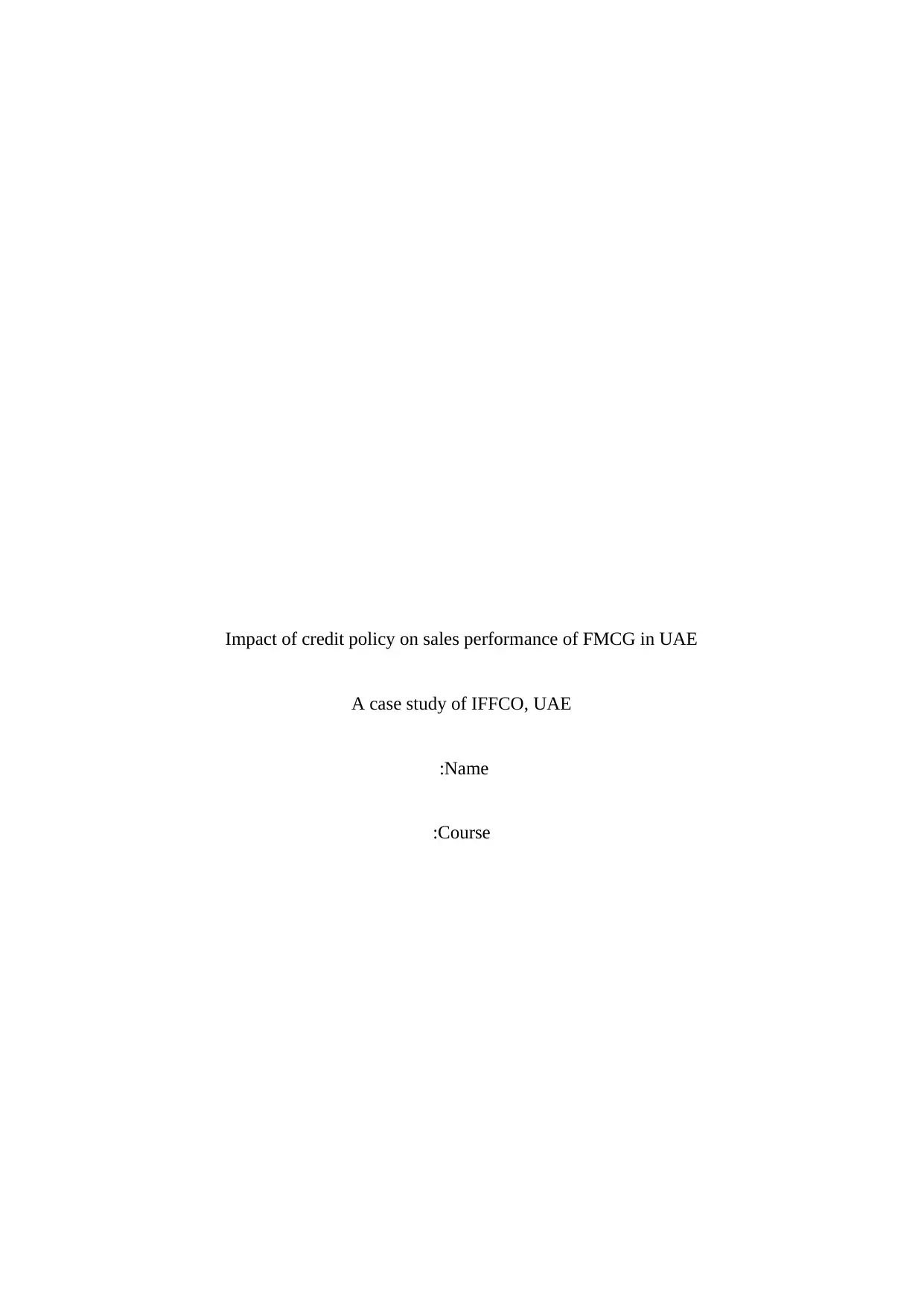
Impact of credit policy on sales performance of FMCG in UAE
A case study of IFFCO, UAE
Name:
Course:
A case study of IFFCO, UAE
Name:
Course:
Paraphrase This Document
Need a fresh take? Get an instant paraphrase of this document with our AI Paraphraser
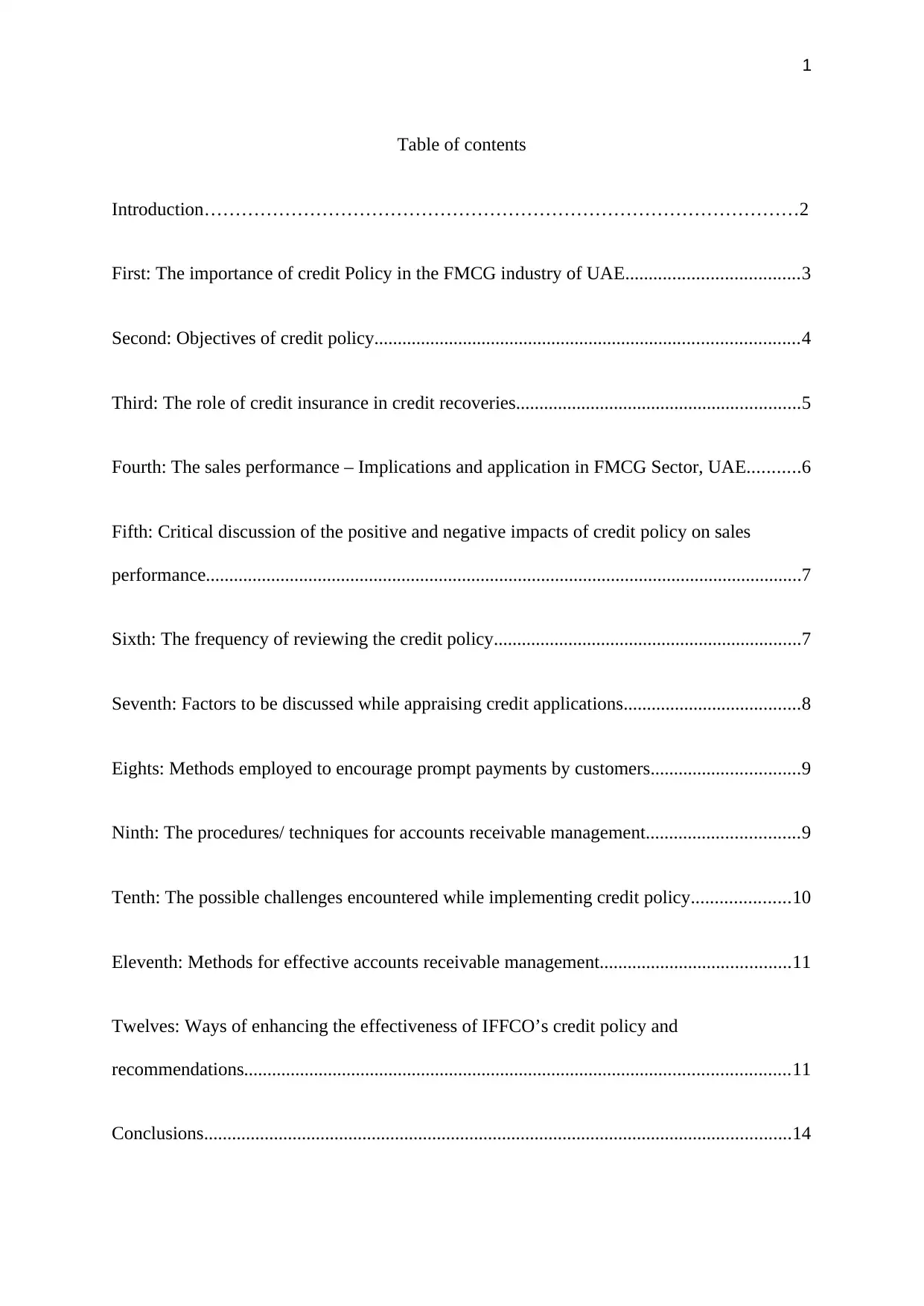
1
Table of contents
Introduction……………………………………………………………………………………2
First: The importance of credit Policy in the FMCG industry of UAE.....................................3
Second: Objectives of credit policy...........................................................................................4
Third: The role of credit insurance in credit recoveries.............................................................5
Fourth: The sales performance – Implications and application in FMCG Sector, UAE...........6
Fifth: Critical discussion of the positive and negative impacts of credit policy on sales
performance................................................................................................................................7
Sixth: The frequency of reviewing the credit policy..................................................................7
Seventh: Factors to be discussed while appraising credit applications......................................8
Eights: Methods employed to encourage prompt payments by customers................................9
Ninth: The procedures/ techniques for accounts receivable management.................................9
Tenth: The possible challenges encountered while implementing credit policy.....................10
Eleventh: Methods for effective accounts receivable management.........................................11
Twelves: Ways of enhancing the effectiveness of IFFCO’s credit policy and
recommendations.....................................................................................................................11
Conclusions..............................................................................................................................14
Table of contents
Introduction……………………………………………………………………………………2
First: The importance of credit Policy in the FMCG industry of UAE.....................................3
Second: Objectives of credit policy...........................................................................................4
Third: The role of credit insurance in credit recoveries.............................................................5
Fourth: The sales performance – Implications and application in FMCG Sector, UAE...........6
Fifth: Critical discussion of the positive and negative impacts of credit policy on sales
performance................................................................................................................................7
Sixth: The frequency of reviewing the credit policy..................................................................7
Seventh: Factors to be discussed while appraising credit applications......................................8
Eights: Methods employed to encourage prompt payments by customers................................9
Ninth: The procedures/ techniques for accounts receivable management.................................9
Tenth: The possible challenges encountered while implementing credit policy.....................10
Eleventh: Methods for effective accounts receivable management.........................................11
Twelves: Ways of enhancing the effectiveness of IFFCO’s credit policy and
recommendations.....................................................................................................................11
Conclusions..............................................................................................................................14
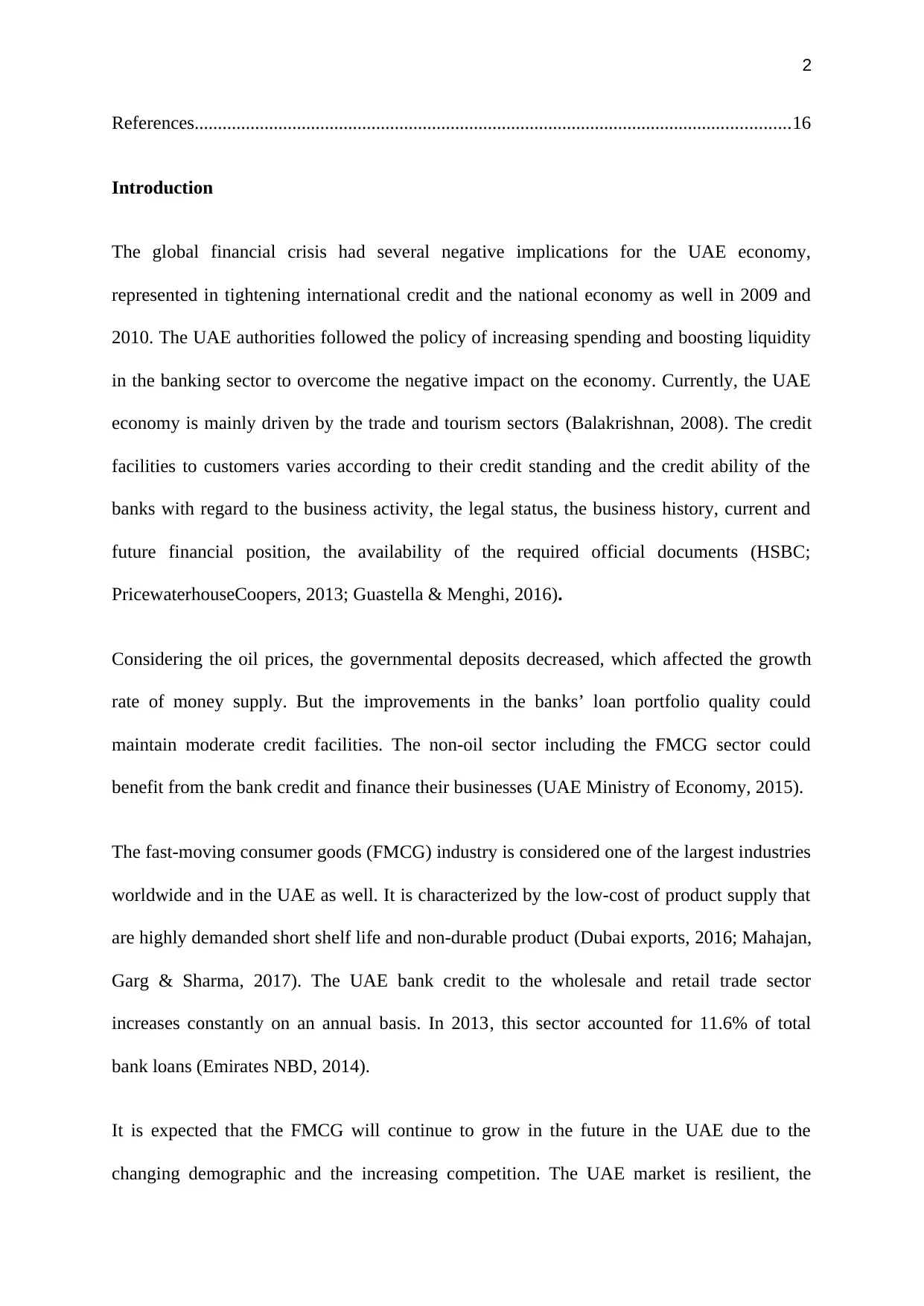
2
References................................................................................................................................16
Introduction
The global financial crisis had several negative implications for the UAE economy,
represented in tightening international credit and the national economy as well in 2009 and
2010. The UAE authorities followed the policy of increasing spending and boosting liquidity
in the banking sector to overcome the negative impact on the economy. Currently, the UAE
economy is mainly driven by the trade and tourism sectors (Balakrishnan, 2008). The credit
facilities to customers varies according to their credit standing and the credit ability of the
banks with regard to the business activity, the legal status, the business history, current and
future financial position, the availability of the required official documents (HSBC;
PricewaterhouseCoopers, 2013; Guastella & Menghi, 2016).
Considering the oil prices, the governmental deposits decreased, which affected the growth
rate of money supply. But the improvements in the banks’ loan portfolio quality could
maintain moderate credit facilities. The non-oil sector including the FMCG sector could
benefit from the bank credit and finance their businesses (UAE Ministry of Economy, 2015).
The fast-moving consumer goods (FMCG) industry is considered one of the largest industries
worldwide and in the UAE as well. It is characterized by the low-cost of product supply that
are highly demanded short shelf life and non-durable product (Dubai exports, 2016; Mahajan,
Garg & Sharma, 2017). The UAE bank credit to the wholesale and retail trade sector
increases constantly on an annual basis. In 2013, this sector accounted for 11.6% of total
bank loans (Emirates NBD, 2014).
It is expected that the FMCG will continue to grow in the future in the UAE due to the
changing demographic and the increasing competition. The UAE market is resilient, the
References................................................................................................................................16
Introduction
The global financial crisis had several negative implications for the UAE economy,
represented in tightening international credit and the national economy as well in 2009 and
2010. The UAE authorities followed the policy of increasing spending and boosting liquidity
in the banking sector to overcome the negative impact on the economy. Currently, the UAE
economy is mainly driven by the trade and tourism sectors (Balakrishnan, 2008). The credit
facilities to customers varies according to their credit standing and the credit ability of the
banks with regard to the business activity, the legal status, the business history, current and
future financial position, the availability of the required official documents (HSBC;
PricewaterhouseCoopers, 2013; Guastella & Menghi, 2016).
Considering the oil prices, the governmental deposits decreased, which affected the growth
rate of money supply. But the improvements in the banks’ loan portfolio quality could
maintain moderate credit facilities. The non-oil sector including the FMCG sector could
benefit from the bank credit and finance their businesses (UAE Ministry of Economy, 2015).
The fast-moving consumer goods (FMCG) industry is considered one of the largest industries
worldwide and in the UAE as well. It is characterized by the low-cost of product supply that
are highly demanded short shelf life and non-durable product (Dubai exports, 2016; Mahajan,
Garg & Sharma, 2017). The UAE bank credit to the wholesale and retail trade sector
increases constantly on an annual basis. In 2013, this sector accounted for 11.6% of total
bank loans (Emirates NBD, 2014).
It is expected that the FMCG will continue to grow in the future in the UAE due to the
changing demographic and the increasing competition. The UAE market is resilient, the
⊘ This is a preview!⊘
Do you want full access?
Subscribe today to unlock all pages.

Trusted by 1+ million students worldwide
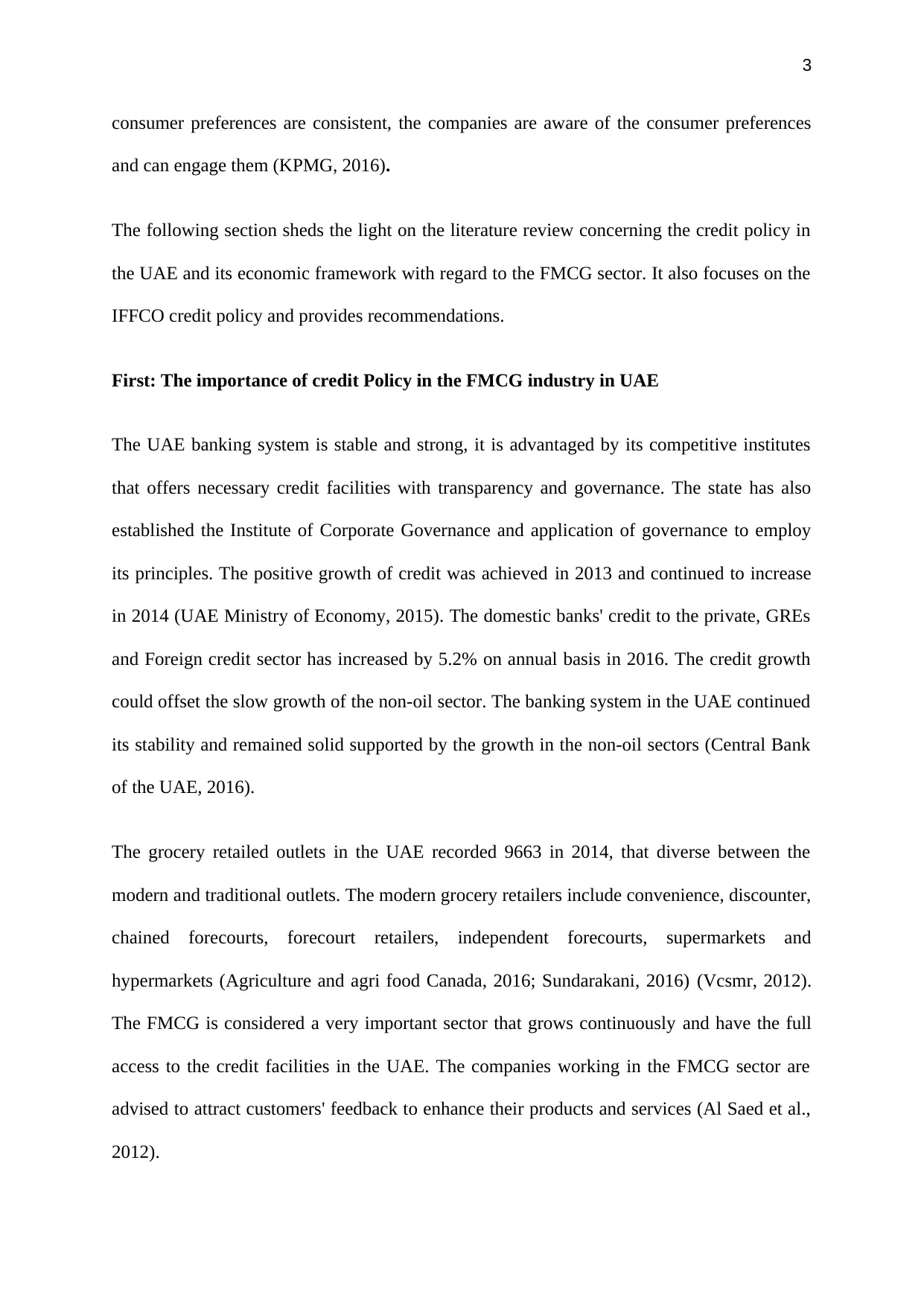
3
consumer preferences are consistent, the companies are aware of the consumer preferences
and can engage them (KPMG, 2016).
The following section sheds the light on the literature review concerning the credit policy in
the UAE and its economic framework with regard to the FMCG sector. It also focuses on the
IFFCO credit policy and provides recommendations.
First: The importance of credit Policy in the FMCG industry in UAE
The UAE banking system is stable and strong, it is advantaged by its competitive institutes
that offers necessary credit facilities with transparency and governance. The state has also
established the Institute of Corporate Governance and application of governance to employ
its principles. The positive growth of credit was achieved in 2013 and continued to increase
in 2014 (UAE Ministry of Economy, 2015). The domestic banks' credit to the private, GREs
and Foreign credit sector has increased by 5.2% on annual basis in 2016. The credit growth
could offset the slow growth of the non-oil sector. The banking system in the UAE continued
its stability and remained solid supported by the growth in the non-oil sectors (Central Bank
of the UAE, 2016).
The grocery retailed outlets in the UAE recorded 9663 in 2014, that diverse between the
modern and traditional outlets. The modern grocery retailers include convenience, discounter,
chained forecourts, forecourt retailers, independent forecourts, supermarkets and
hypermarkets (Agriculture and agri food Canada, 2016; Sundarakani, 2016) (Vcsmr, 2012).
The FMCG is considered a very important sector that grows continuously and have the full
access to the credit facilities in the UAE. The companies working in the FMCG sector are
advised to attract customers' feedback to enhance their products and services (Al Saed et al.,
2012).
consumer preferences are consistent, the companies are aware of the consumer preferences
and can engage them (KPMG, 2016).
The following section sheds the light on the literature review concerning the credit policy in
the UAE and its economic framework with regard to the FMCG sector. It also focuses on the
IFFCO credit policy and provides recommendations.
First: The importance of credit Policy in the FMCG industry in UAE
The UAE banking system is stable and strong, it is advantaged by its competitive institutes
that offers necessary credit facilities with transparency and governance. The state has also
established the Institute of Corporate Governance and application of governance to employ
its principles. The positive growth of credit was achieved in 2013 and continued to increase
in 2014 (UAE Ministry of Economy, 2015). The domestic banks' credit to the private, GREs
and Foreign credit sector has increased by 5.2% on annual basis in 2016. The credit growth
could offset the slow growth of the non-oil sector. The banking system in the UAE continued
its stability and remained solid supported by the growth in the non-oil sectors (Central Bank
of the UAE, 2016).
The grocery retailed outlets in the UAE recorded 9663 in 2014, that diverse between the
modern and traditional outlets. The modern grocery retailers include convenience, discounter,
chained forecourts, forecourt retailers, independent forecourts, supermarkets and
hypermarkets (Agriculture and agri food Canada, 2016; Sundarakani, 2016) (Vcsmr, 2012).
The FMCG is considered a very important sector that grows continuously and have the full
access to the credit facilities in the UAE. The companies working in the FMCG sector are
advised to attract customers' feedback to enhance their products and services (Al Saed et al.,
2012).
Paraphrase This Document
Need a fresh take? Get an instant paraphrase of this document with our AI Paraphraser
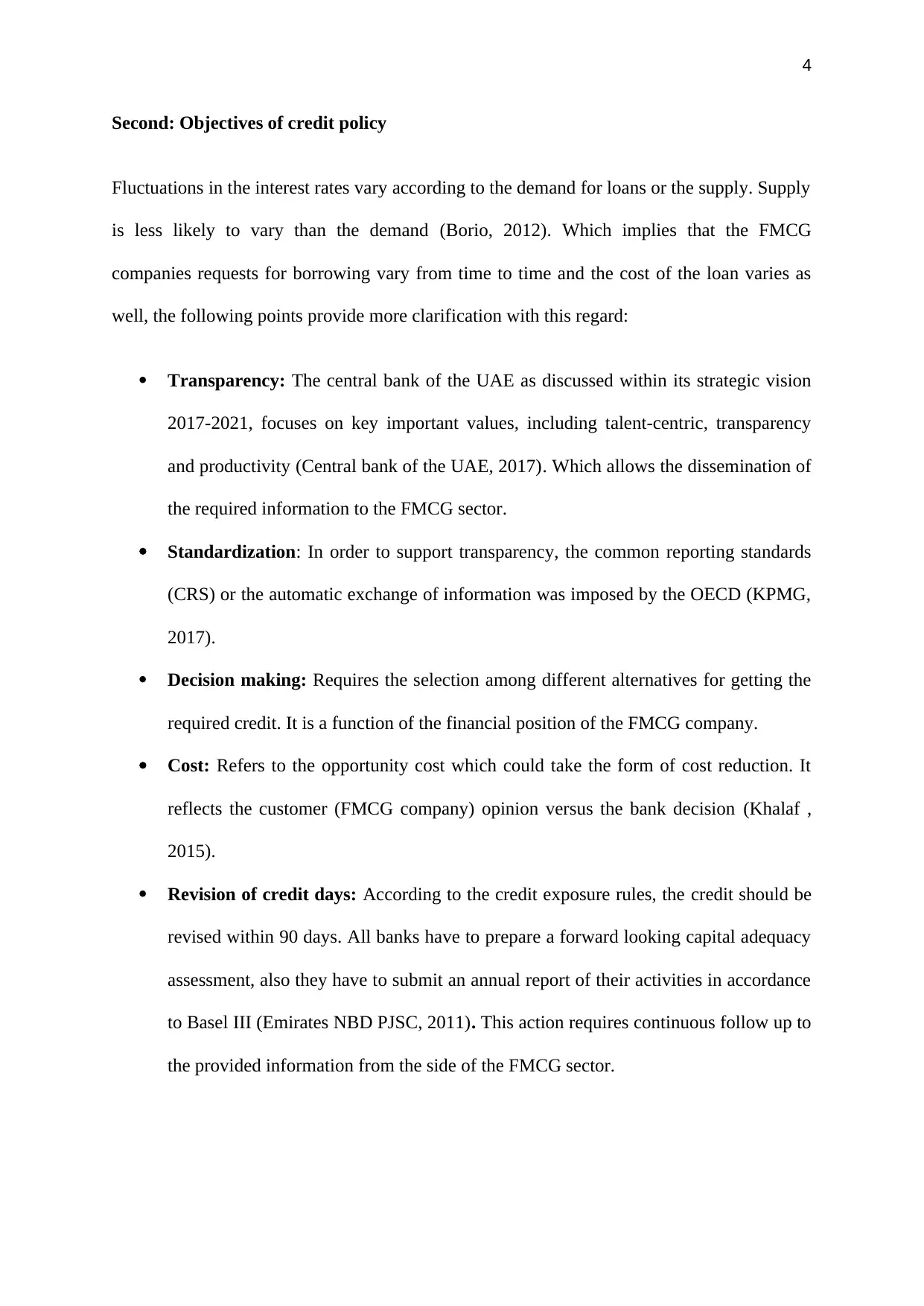
4
Second: Objectives of credit policy
Fluctuations in the interest rates vary according to the demand for loans or the supply. Supply
is less likely to vary than the demand (Borio, 2012). Which implies that the FMCG
companies requests for borrowing vary from time to time and the cost of the loan varies as
well, the following points provide more clarification with this regard:
Transparency: The central bank of the UAE as discussed within its strategic vision
2017-2021, focuses on key important values, including talent-centric, transparency
and productivity (Central bank of the UAE, 2017). Which allows the dissemination of
the required information to the FMCG sector.
Standardization: In order to support transparency, the common reporting standards
(CRS) or the automatic exchange of information was imposed by the OECD (KPMG,
2017).
Decision making: Requires the selection among different alternatives for getting the
required credit. It is a function of the financial position of the FMCG company.
Cost: Refers to the opportunity cost which could take the form of cost reduction. It
reflects the customer (FMCG company) opinion versus the bank decision (Khalaf ,
2015).
Revision of credit days: According to the credit exposure rules, the credit should be
revised within 90 days. All banks have to prepare a forward looking capital adequacy
assessment, also they have to submit an annual report of their activities in accordance
to Basel III (Emirates NBD PJSC, 2011). This action requires continuous follow up to
the provided information from the side of the FMCG sector.
Second: Objectives of credit policy
Fluctuations in the interest rates vary according to the demand for loans or the supply. Supply
is less likely to vary than the demand (Borio, 2012). Which implies that the FMCG
companies requests for borrowing vary from time to time and the cost of the loan varies as
well, the following points provide more clarification with this regard:
Transparency: The central bank of the UAE as discussed within its strategic vision
2017-2021, focuses on key important values, including talent-centric, transparency
and productivity (Central bank of the UAE, 2017). Which allows the dissemination of
the required information to the FMCG sector.
Standardization: In order to support transparency, the common reporting standards
(CRS) or the automatic exchange of information was imposed by the OECD (KPMG,
2017).
Decision making: Requires the selection among different alternatives for getting the
required credit. It is a function of the financial position of the FMCG company.
Cost: Refers to the opportunity cost which could take the form of cost reduction. It
reflects the customer (FMCG company) opinion versus the bank decision (Khalaf ,
2015).
Revision of credit days: According to the credit exposure rules, the credit should be
revised within 90 days. All banks have to prepare a forward looking capital adequacy
assessment, also they have to submit an annual report of their activities in accordance
to Basel III (Emirates NBD PJSC, 2011). This action requires continuous follow up to
the provided information from the side of the FMCG sector.
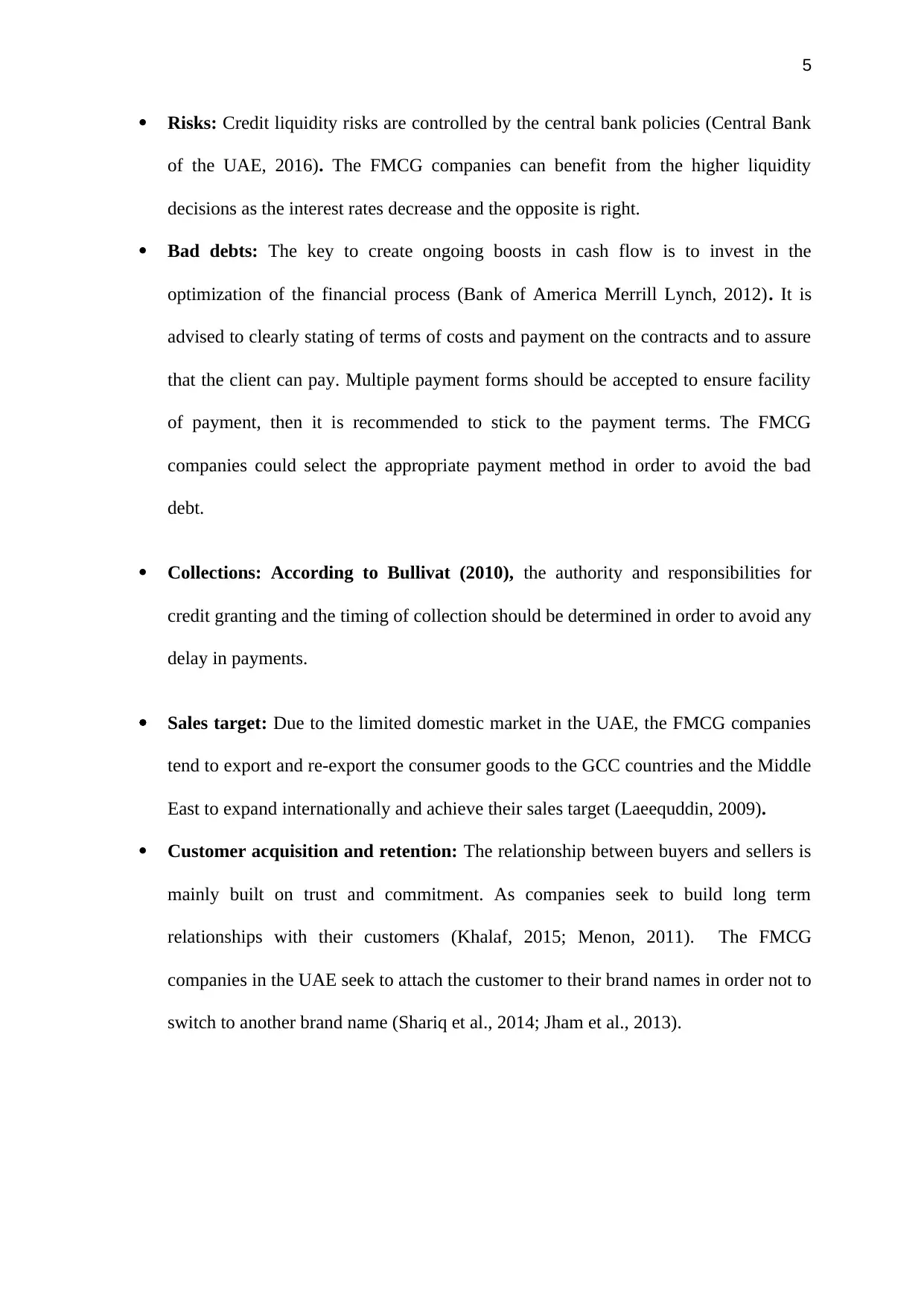
5
Risks: Credit liquidity risks are controlled by the central bank policies (Central Bank
of the UAE, 2016). The FMCG companies can benefit from the higher liquidity
decisions as the interest rates decrease and the opposite is right.
Bad debts: The key to create ongoing boosts in cash flow is to invest in the
optimization of the financial process (Bank of America Merrill Lynch, 2012). It is
advised to clearly stating of terms of costs and payment on the contracts and to assure
that the client can pay. Multiple payment forms should be accepted to ensure facility
of payment, then it is recommended to stick to the payment terms. The FMCG
companies could select the appropriate payment method in order to avoid the bad
debt.
Collections: According to Bullivat (2010), the authority and responsibilities for
credit granting and the timing of collection should be determined in order to avoid any
delay in payments.
Sales target: Due to the limited domestic market in the UAE, the FMCG companies
tend to export and re-export the consumer goods to the GCC countries and the Middle
East to expand internationally and achieve their sales target (Laeequddin, 2009).
Customer acquisition and retention: The relationship between buyers and sellers is
mainly built on trust and commitment. As companies seek to build long term
relationships with their customers (Khalaf, 2015; Menon, 2011). The FMCG
companies in the UAE seek to attach the customer to their brand names in order not to
switch to another brand name (Shariq et al., 2014; Jham et al., 2013).
Risks: Credit liquidity risks are controlled by the central bank policies (Central Bank
of the UAE, 2016). The FMCG companies can benefit from the higher liquidity
decisions as the interest rates decrease and the opposite is right.
Bad debts: The key to create ongoing boosts in cash flow is to invest in the
optimization of the financial process (Bank of America Merrill Lynch, 2012). It is
advised to clearly stating of terms of costs and payment on the contracts and to assure
that the client can pay. Multiple payment forms should be accepted to ensure facility
of payment, then it is recommended to stick to the payment terms. The FMCG
companies could select the appropriate payment method in order to avoid the bad
debt.
Collections: According to Bullivat (2010), the authority and responsibilities for
credit granting and the timing of collection should be determined in order to avoid any
delay in payments.
Sales target: Due to the limited domestic market in the UAE, the FMCG companies
tend to export and re-export the consumer goods to the GCC countries and the Middle
East to expand internationally and achieve their sales target (Laeequddin, 2009).
Customer acquisition and retention: The relationship between buyers and sellers is
mainly built on trust and commitment. As companies seek to build long term
relationships with their customers (Khalaf, 2015; Menon, 2011). The FMCG
companies in the UAE seek to attach the customer to their brand names in order not to
switch to another brand name (Shariq et al., 2014; Jham et al., 2013).
⊘ This is a preview!⊘
Do you want full access?
Subscribe today to unlock all pages.

Trusted by 1+ million students worldwide
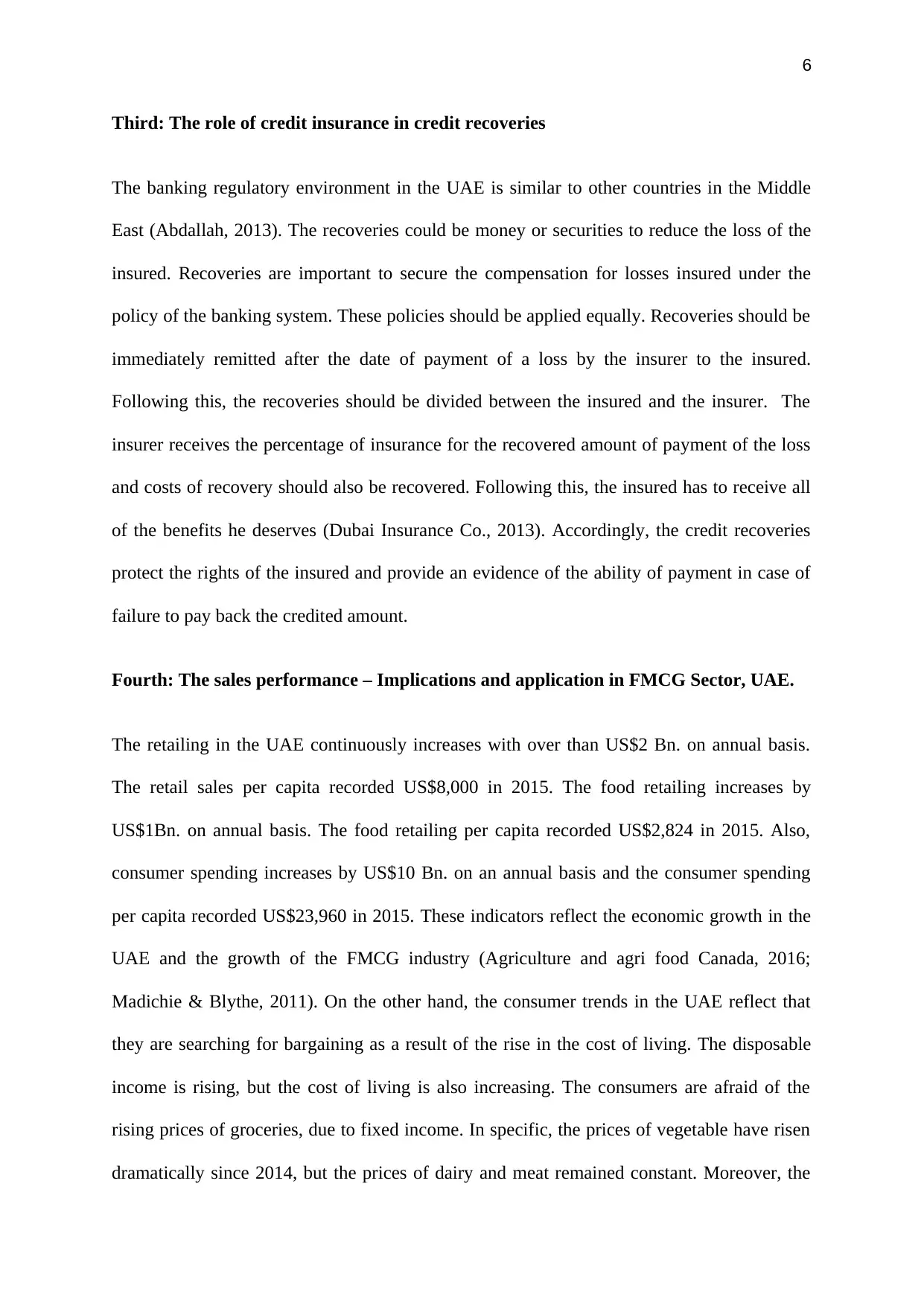
6
Third: The role of credit insurance in credit recoveries
The banking regulatory environment in the UAE is similar to other countries in the Middle
East (Abdallah, 2013). The recoveries could be money or securities to reduce the loss of the
insured. Recoveries are important to secure the compensation for losses insured under the
policy of the banking system. These policies should be applied equally. Recoveries should be
immediately remitted after the date of payment of a loss by the insurer to the insured.
Following this, the recoveries should be divided between the insured and the insurer. The
insurer receives the percentage of insurance for the recovered amount of payment of the loss
and costs of recovery should also be recovered. Following this, the insured has to receive all
of the benefits he deserves (Dubai Insurance Co., 2013). Accordingly, the credit recoveries
protect the rights of the insured and provide an evidence of the ability of payment in case of
failure to pay back the credited amount.
Fourth: The sales performance – Implications and application in FMCG Sector, UAE.
The retailing in the UAE continuously increases with over than US$2 Bn. on annual basis.
The retail sales per capita recorded US$8,000 in 2015. The food retailing increases by
US$1Bn. on annual basis. The food retailing per capita recorded US$2,824 in 2015. Also,
consumer spending increases by US$10 Bn. on an annual basis and the consumer spending
per capita recorded US$23,960 in 2015. These indicators reflect the economic growth in the
UAE and the growth of the FMCG industry (Agriculture and agri food Canada, 2016;
Madichie & Blythe, 2011). On the other hand, the consumer trends in the UAE reflect that
they are searching for bargaining as a result of the rise in the cost of living. The disposable
income is rising, but the cost of living is also increasing. The consumers are afraid of the
rising prices of groceries, due to fixed income. In specific, the prices of vegetable have risen
dramatically since 2014, but the prices of dairy and meat remained constant. Moreover, the
Third: The role of credit insurance in credit recoveries
The banking regulatory environment in the UAE is similar to other countries in the Middle
East (Abdallah, 2013). The recoveries could be money or securities to reduce the loss of the
insured. Recoveries are important to secure the compensation for losses insured under the
policy of the banking system. These policies should be applied equally. Recoveries should be
immediately remitted after the date of payment of a loss by the insurer to the insured.
Following this, the recoveries should be divided between the insured and the insurer. The
insurer receives the percentage of insurance for the recovered amount of payment of the loss
and costs of recovery should also be recovered. Following this, the insured has to receive all
of the benefits he deserves (Dubai Insurance Co., 2013). Accordingly, the credit recoveries
protect the rights of the insured and provide an evidence of the ability of payment in case of
failure to pay back the credited amount.
Fourth: The sales performance – Implications and application in FMCG Sector, UAE.
The retailing in the UAE continuously increases with over than US$2 Bn. on annual basis.
The retail sales per capita recorded US$8,000 in 2015. The food retailing increases by
US$1Bn. on annual basis. The food retailing per capita recorded US$2,824 in 2015. Also,
consumer spending increases by US$10 Bn. on an annual basis and the consumer spending
per capita recorded US$23,960 in 2015. These indicators reflect the economic growth in the
UAE and the growth of the FMCG industry (Agriculture and agri food Canada, 2016;
Madichie & Blythe, 2011). On the other hand, the consumer trends in the UAE reflect that
they are searching for bargaining as a result of the rise in the cost of living. The disposable
income is rising, but the cost of living is also increasing. The consumers are afraid of the
rising prices of groceries, due to fixed income. In specific, the prices of vegetable have risen
dramatically since 2014, but the prices of dairy and meat remained constant. Moreover, the
Paraphrase This Document
Need a fresh take? Get an instant paraphrase of this document with our AI Paraphraser
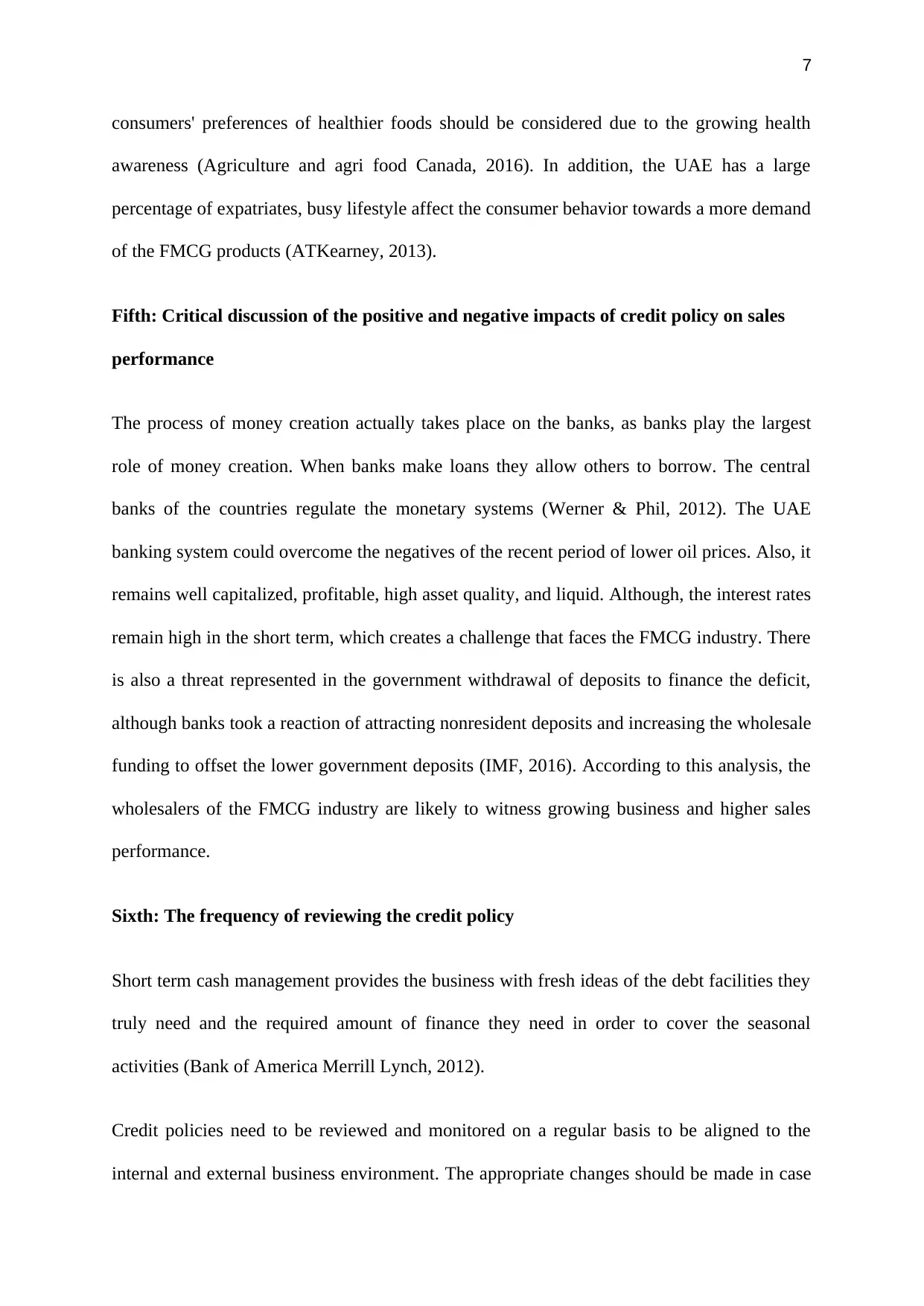
7
consumers' preferences of healthier foods should be considered due to the growing health
awareness (Agriculture and agri food Canada, 2016). In addition, the UAE has a large
percentage of expatriates, busy lifestyle affect the consumer behavior towards a more demand
of the FMCG products (ATKearney, 2013).
Fifth: Critical discussion of the positive and negative impacts of credit policy on sales
performance
The process of money creation actually takes place on the banks, as banks play the largest
role of money creation. When banks make loans they allow others to borrow. The central
banks of the countries regulate the monetary systems (Werner & Phil, 2012). The UAE
banking system could overcome the negatives of the recent period of lower oil prices. Also, it
remains well capitalized, profitable, high asset quality, and liquid. Although, the interest rates
remain high in the short term, which creates a challenge that faces the FMCG industry. There
is also a threat represented in the government withdrawal of deposits to finance the deficit,
although banks took a reaction of attracting nonresident deposits and increasing the wholesale
funding to offset the lower government deposits (IMF, 2016). According to this analysis, the
wholesalers of the FMCG industry are likely to witness growing business and higher sales
performance.
Sixth: The frequency of reviewing the credit policy
Short term cash management provides the business with fresh ideas of the debt facilities they
truly need and the required amount of finance they need in order to cover the seasonal
activities (Bank of America Merrill Lynch, 2012).
Credit policies need to be reviewed and monitored on a regular basis to be aligned to the
internal and external business environment. The appropriate changes should be made in case
consumers' preferences of healthier foods should be considered due to the growing health
awareness (Agriculture and agri food Canada, 2016). In addition, the UAE has a large
percentage of expatriates, busy lifestyle affect the consumer behavior towards a more demand
of the FMCG products (ATKearney, 2013).
Fifth: Critical discussion of the positive and negative impacts of credit policy on sales
performance
The process of money creation actually takes place on the banks, as banks play the largest
role of money creation. When banks make loans they allow others to borrow. The central
banks of the countries regulate the monetary systems (Werner & Phil, 2012). The UAE
banking system could overcome the negatives of the recent period of lower oil prices. Also, it
remains well capitalized, profitable, high asset quality, and liquid. Although, the interest rates
remain high in the short term, which creates a challenge that faces the FMCG industry. There
is also a threat represented in the government withdrawal of deposits to finance the deficit,
although banks took a reaction of attracting nonresident deposits and increasing the wholesale
funding to offset the lower government deposits (IMF, 2016). According to this analysis, the
wholesalers of the FMCG industry are likely to witness growing business and higher sales
performance.
Sixth: The frequency of reviewing the credit policy
Short term cash management provides the business with fresh ideas of the debt facilities they
truly need and the required amount of finance they need in order to cover the seasonal
activities (Bank of America Merrill Lynch, 2012).
Credit policies need to be reviewed and monitored on a regular basis to be aligned to the
internal and external business environment. The appropriate changes should be made in case
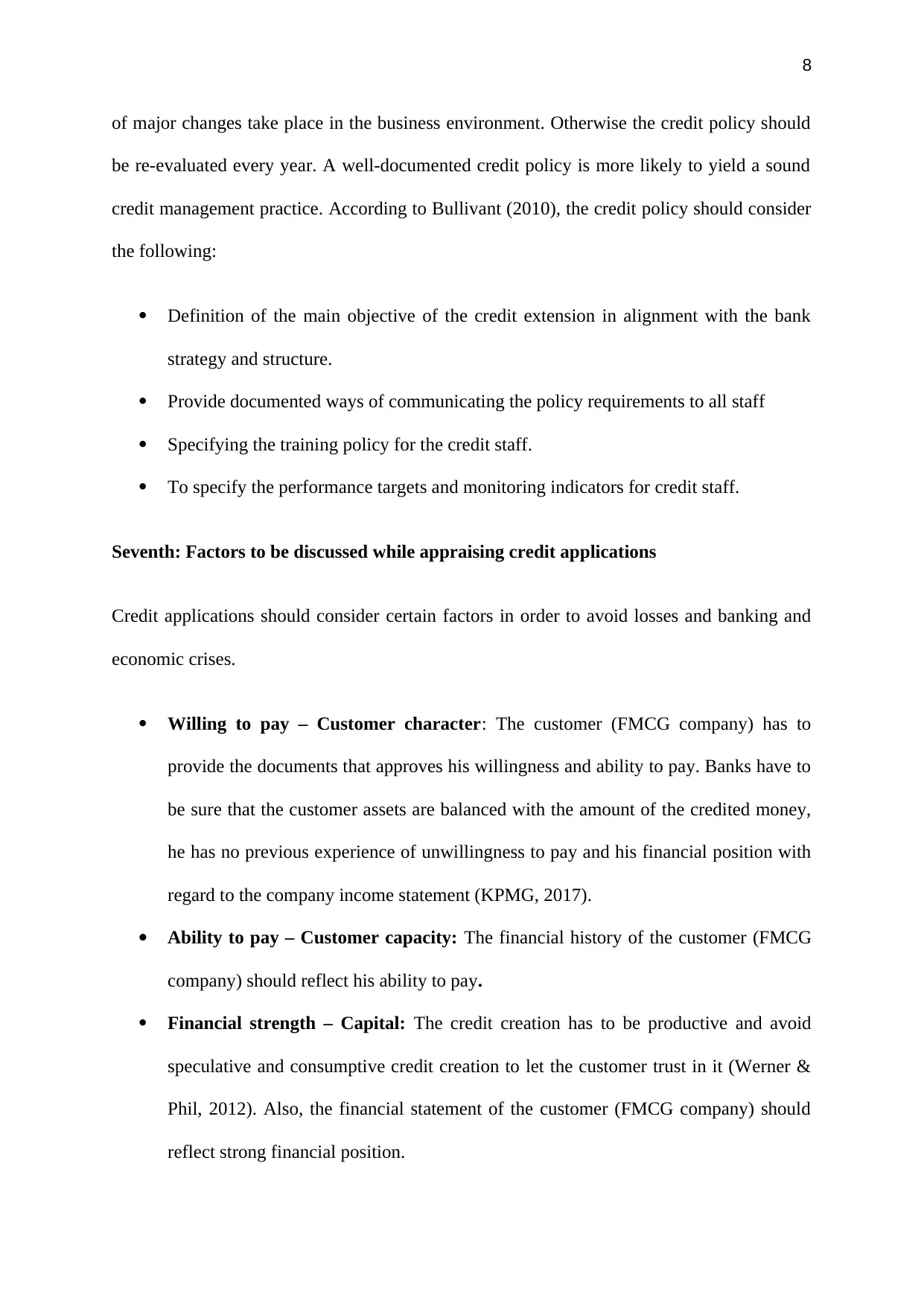
8
of major changes take place in the business environment. Otherwise the credit policy should
be re-evaluated every year. A well-documented credit policy is more likely to yield a sound
credit management practice. According to Bullivant (2010), the credit policy should consider
the following:
Definition of the main objective of the credit extension in alignment with the bank
strategy and structure.
Provide documented ways of communicating the policy requirements to all staff
Specifying the training policy for the credit staff.
To specify the performance targets and monitoring indicators for credit staff.
Seventh: Factors to be discussed while appraising credit applications
Credit applications should consider certain factors in order to avoid losses and banking and
economic crises.
Willing to pay – Customer character: The customer (FMCG company) has to
provide the documents that approves his willingness and ability to pay. Banks have to
be sure that the customer assets are balanced with the amount of the credited money,
he has no previous experience of unwillingness to pay and his financial position with
regard to the company income statement (KPMG, 2017).
Ability to pay – Customer capacity: The financial history of the customer (FMCG
company) should reflect his ability to pay.
Financial strength – Capital: The credit creation has to be productive and avoid
speculative and consumptive credit creation to let the customer trust in it (Werner &
Phil, 2012). Also, the financial statement of the customer (FMCG company) should
reflect strong financial position.
of major changes take place in the business environment. Otherwise the credit policy should
be re-evaluated every year. A well-documented credit policy is more likely to yield a sound
credit management practice. According to Bullivant (2010), the credit policy should consider
the following:
Definition of the main objective of the credit extension in alignment with the bank
strategy and structure.
Provide documented ways of communicating the policy requirements to all staff
Specifying the training policy for the credit staff.
To specify the performance targets and monitoring indicators for credit staff.
Seventh: Factors to be discussed while appraising credit applications
Credit applications should consider certain factors in order to avoid losses and banking and
economic crises.
Willing to pay – Customer character: The customer (FMCG company) has to
provide the documents that approves his willingness and ability to pay. Banks have to
be sure that the customer assets are balanced with the amount of the credited money,
he has no previous experience of unwillingness to pay and his financial position with
regard to the company income statement (KPMG, 2017).
Ability to pay – Customer capacity: The financial history of the customer (FMCG
company) should reflect his ability to pay.
Financial strength – Capital: The credit creation has to be productive and avoid
speculative and consumptive credit creation to let the customer trust in it (Werner &
Phil, 2012). Also, the financial statement of the customer (FMCG company) should
reflect strong financial position.
⊘ This is a preview!⊘
Do you want full access?
Subscribe today to unlock all pages.

Trusted by 1+ million students worldwide
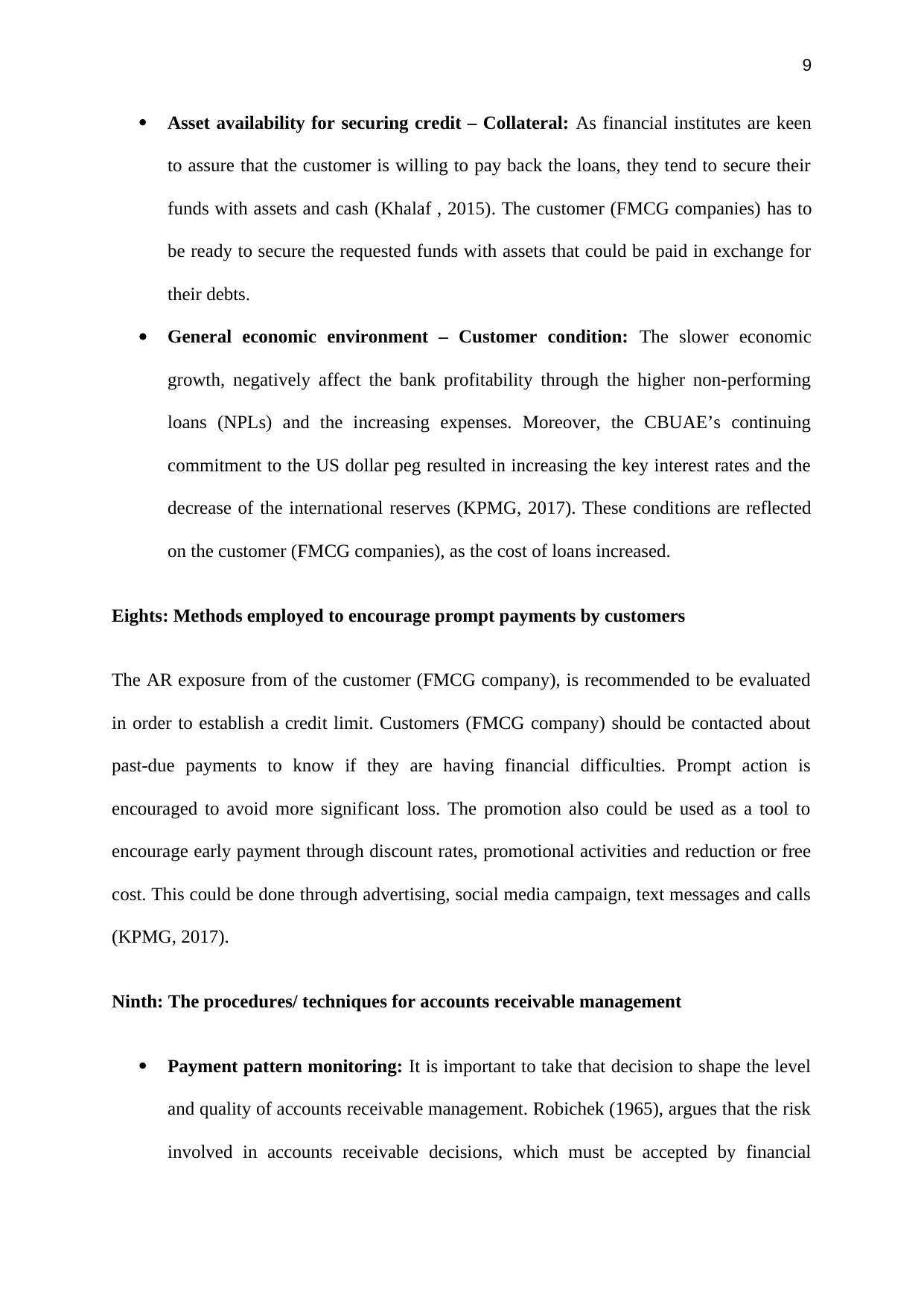
9
Asset availability for securing credit – Collateral: As financial institutes are keen
to assure that the customer is willing to pay back the loans, they tend to secure their
funds with assets and cash (Khalaf , 2015). The customer (FMCG companies) has to
be ready to secure the requested funds with assets that could be paid in exchange for
their debts.
General economic environment – Customer condition: The slower economic
growth, negatively affect the bank profitability through the higher non-performing
loans (NPLs) and the increasing expenses. Moreover, the CBUAE’s continuing
commitment to the US dollar peg resulted in increasing the key interest rates and the
decrease of the international reserves (KPMG, 2017). These conditions are reflected
on the customer (FMCG companies), as the cost of loans increased.
Eights: Methods employed to encourage prompt payments by customers
The AR exposure from of the customer (FMCG company), is recommended to be evaluated
in order to establish a credit limit. Customers (FMCG company) should be contacted about
past-due payments to know if they are having financial difficulties. Prompt action is
encouraged to avoid more significant loss. The promotion also could be used as a tool to
encourage early payment through discount rates, promotional activities and reduction or free
cost. This could be done through advertising, social media campaign, text messages and calls
(KPMG, 2017).
Ninth: The procedures/ techniques for accounts receivable management
Payment pattern monitoring: It is important to take that decision to shape the level
and quality of accounts receivable management. Robichek (1965), argues that the risk
involved in accounts receivable decisions, which must be accepted by financial
Asset availability for securing credit – Collateral: As financial institutes are keen
to assure that the customer is willing to pay back the loans, they tend to secure their
funds with assets and cash (Khalaf , 2015). The customer (FMCG companies) has to
be ready to secure the requested funds with assets that could be paid in exchange for
their debts.
General economic environment – Customer condition: The slower economic
growth, negatively affect the bank profitability through the higher non-performing
loans (NPLs) and the increasing expenses. Moreover, the CBUAE’s continuing
commitment to the US dollar peg resulted in increasing the key interest rates and the
decrease of the international reserves (KPMG, 2017). These conditions are reflected
on the customer (FMCG companies), as the cost of loans increased.
Eights: Methods employed to encourage prompt payments by customers
The AR exposure from of the customer (FMCG company), is recommended to be evaluated
in order to establish a credit limit. Customers (FMCG company) should be contacted about
past-due payments to know if they are having financial difficulties. Prompt action is
encouraged to avoid more significant loss. The promotion also could be used as a tool to
encourage early payment through discount rates, promotional activities and reduction or free
cost. This could be done through advertising, social media campaign, text messages and calls
(KPMG, 2017).
Ninth: The procedures/ techniques for accounts receivable management
Payment pattern monitoring: It is important to take that decision to shape the level
and quality of accounts receivable management. Robichek (1965), argues that the risk
involved in accounts receivable decisions, which must be accepted by financial
Paraphrase This Document
Need a fresh take? Get an instant paraphrase of this document with our AI Paraphraser
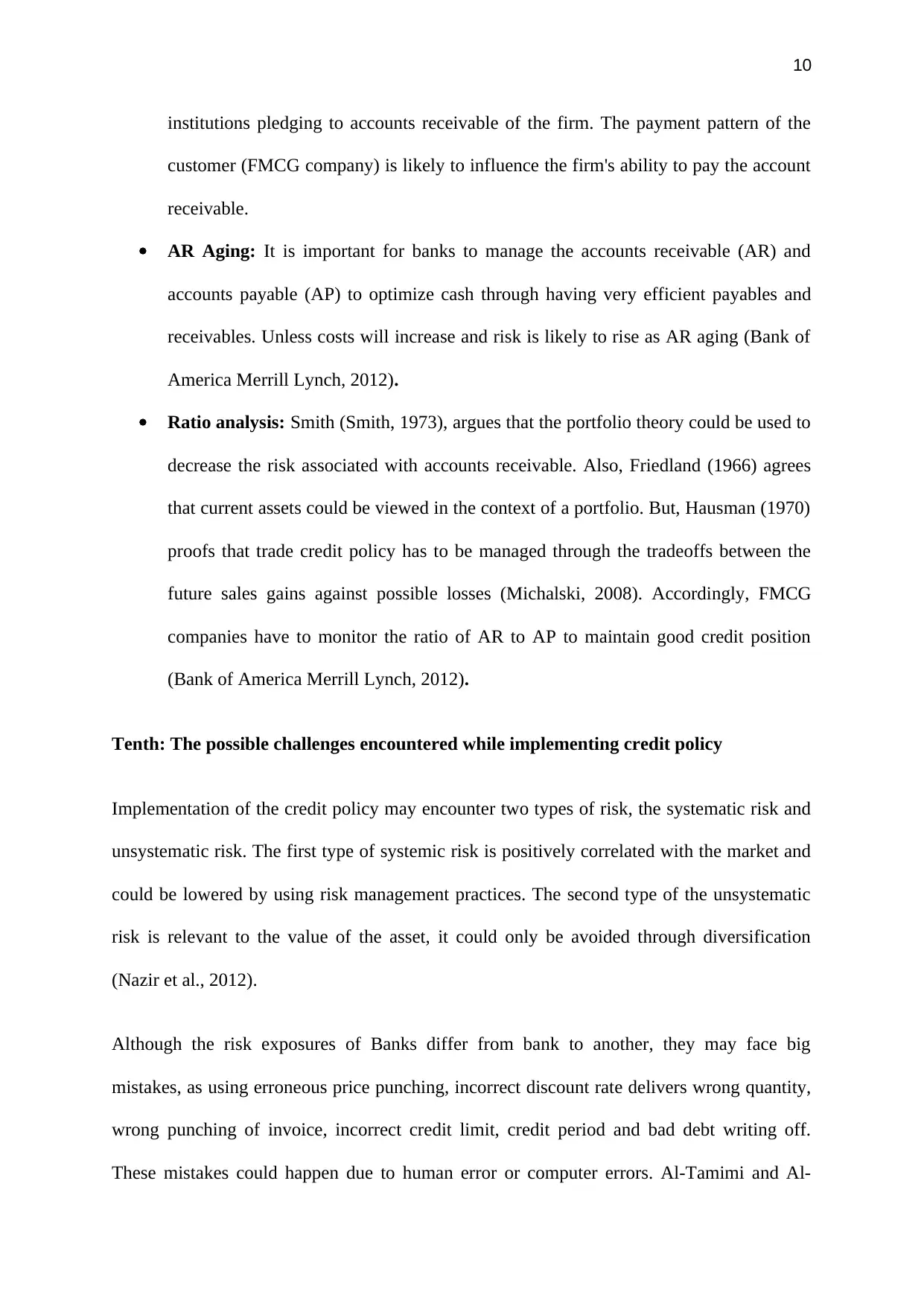
10
institutions pledging to accounts receivable of the firm. The payment pattern of the
customer (FMCG company) is likely to influence the firm's ability to pay the account
receivable.
AR Aging: It is important for banks to manage the accounts receivable (AR) and
accounts payable (AP) to optimize cash through having very efficient payables and
receivables. Unless costs will increase and risk is likely to rise as AR aging (Bank of
America Merrill Lynch, 2012).
Ratio analysis: Smith (Smith, 1973), argues that the portfolio theory could be used to
decrease the risk associated with accounts receivable. Also, Friedland (1966) agrees
that current assets could be viewed in the context of a portfolio. But, Hausman (1970)
proofs that trade credit policy has to be managed through the tradeoffs between the
future sales gains against possible losses (Michalski, 2008). Accordingly, FMCG
companies have to monitor the ratio of AR to AP to maintain good credit position
(Bank of America Merrill Lynch, 2012).
Tenth: The possible challenges encountered while implementing credit policy
Implementation of the credit policy may encounter two types of risk, the systematic risk and
unsystematic risk. The first type of systemic risk is positively correlated with the market and
could be lowered by using risk management practices. The second type of the unsystematic
risk is relevant to the value of the asset, it could only be avoided through diversification
(Nazir et al., 2012).
Although the risk exposures of Banks differ from bank to another, they may face big
mistakes, as using erroneous price punching, incorrect discount rate delivers wrong quantity,
wrong punching of invoice, incorrect credit limit, credit period and bad debt writing off.
These mistakes could happen due to human error or computer errors. Al-Tamimi and Al-
institutions pledging to accounts receivable of the firm. The payment pattern of the
customer (FMCG company) is likely to influence the firm's ability to pay the account
receivable.
AR Aging: It is important for banks to manage the accounts receivable (AR) and
accounts payable (AP) to optimize cash through having very efficient payables and
receivables. Unless costs will increase and risk is likely to rise as AR aging (Bank of
America Merrill Lynch, 2012).
Ratio analysis: Smith (Smith, 1973), argues that the portfolio theory could be used to
decrease the risk associated with accounts receivable. Also, Friedland (1966) agrees
that current assets could be viewed in the context of a portfolio. But, Hausman (1970)
proofs that trade credit policy has to be managed through the tradeoffs between the
future sales gains against possible losses (Michalski, 2008). Accordingly, FMCG
companies have to monitor the ratio of AR to AP to maintain good credit position
(Bank of America Merrill Lynch, 2012).
Tenth: The possible challenges encountered while implementing credit policy
Implementation of the credit policy may encounter two types of risk, the systematic risk and
unsystematic risk. The first type of systemic risk is positively correlated with the market and
could be lowered by using risk management practices. The second type of the unsystematic
risk is relevant to the value of the asset, it could only be avoided through diversification
(Nazir et al., 2012).
Although the risk exposures of Banks differ from bank to another, they may face big
mistakes, as using erroneous price punching, incorrect discount rate delivers wrong quantity,
wrong punching of invoice, incorrect credit limit, credit period and bad debt writing off.
These mistakes could happen due to human error or computer errors. Al-Tamimi and Al-
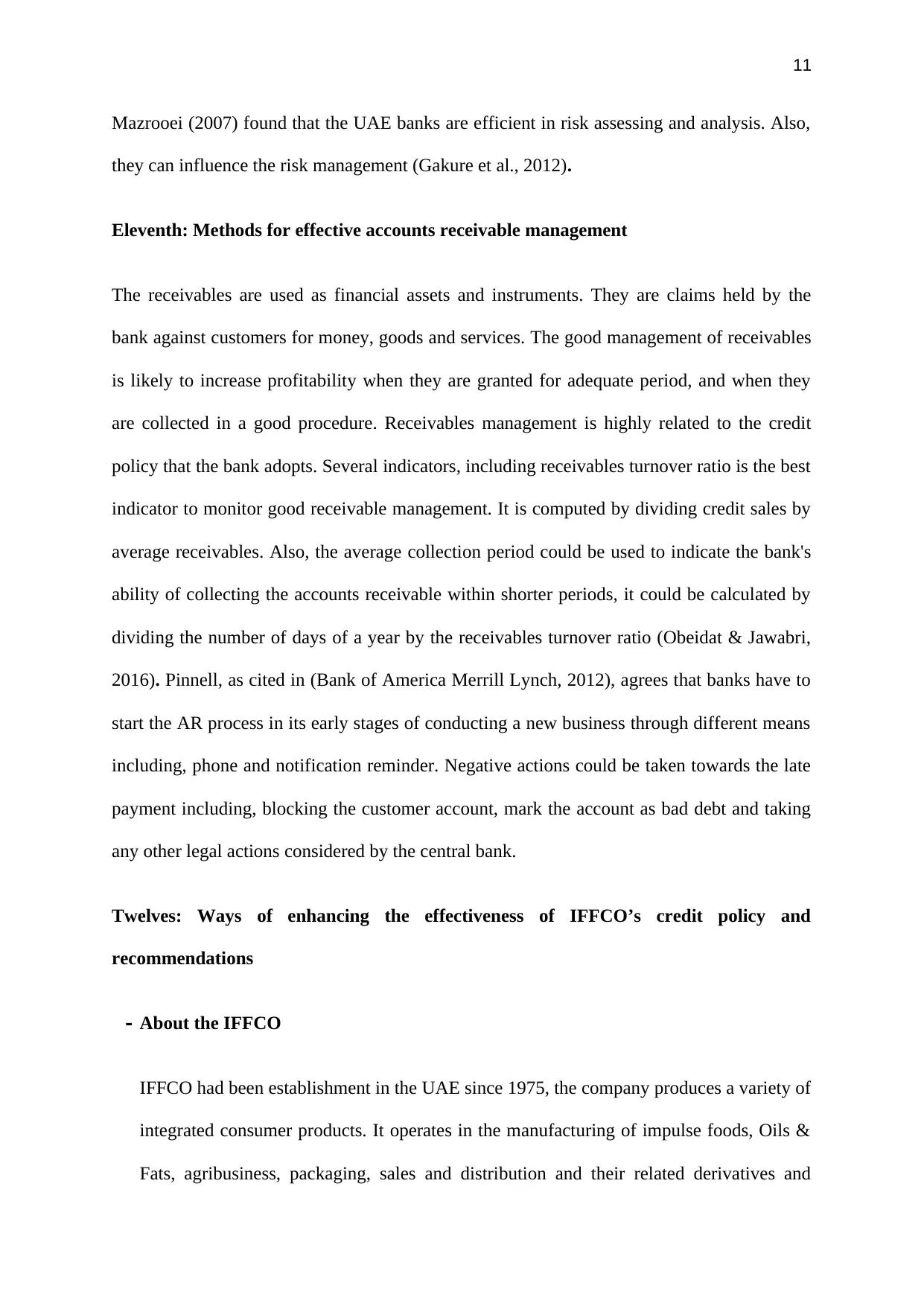
11
Mazrooei (2007) found that the UAE banks are efficient in risk assessing and analysis. Also,
they can influence the risk management (Gakure et al., 2012).
Eleventh: Methods for effective accounts receivable management
The receivables are used as financial assets and instruments. They are claims held by the
bank against customers for money, goods and services. The good management of receivables
is likely to increase profitability when they are granted for adequate period, and when they
are collected in a good procedure. Receivables management is highly related to the credit
policy that the bank adopts. Several indicators, including receivables turnover ratio is the best
indicator to monitor good receivable management. It is computed by dividing credit sales by
average receivables. Also, the average collection period could be used to indicate the bank's
ability of collecting the accounts receivable within shorter periods, it could be calculated by
dividing the number of days of a year by the receivables turnover ratio (Obeidat & Jawabri,
2016). Pinnell, as cited in (Bank of America Merrill Lynch, 2012), agrees that banks have to
start the AR process in its early stages of conducting a new business through different means
including, phone and notification reminder. Negative actions could be taken towards the late
payment including, blocking the customer account, mark the account as bad debt and taking
any other legal actions considered by the central bank.
Twelves: Ways of enhancing the effectiveness of IFFCO’s credit policy and
recommendations
About the IFFCO
IFFCO had been establishment in the UAE since 1975, the company produces a variety of
integrated consumer products. It operates in the manufacturing of impulse foods, Oils &
Fats, agribusiness, packaging, sales and distribution and their related derivatives and
Mazrooei (2007) found that the UAE banks are efficient in risk assessing and analysis. Also,
they can influence the risk management (Gakure et al., 2012).
Eleventh: Methods for effective accounts receivable management
The receivables are used as financial assets and instruments. They are claims held by the
bank against customers for money, goods and services. The good management of receivables
is likely to increase profitability when they are granted for adequate period, and when they
are collected in a good procedure. Receivables management is highly related to the credit
policy that the bank adopts. Several indicators, including receivables turnover ratio is the best
indicator to monitor good receivable management. It is computed by dividing credit sales by
average receivables. Also, the average collection period could be used to indicate the bank's
ability of collecting the accounts receivable within shorter periods, it could be calculated by
dividing the number of days of a year by the receivables turnover ratio (Obeidat & Jawabri,
2016). Pinnell, as cited in (Bank of America Merrill Lynch, 2012), agrees that banks have to
start the AR process in its early stages of conducting a new business through different means
including, phone and notification reminder. Negative actions could be taken towards the late
payment including, blocking the customer account, mark the account as bad debt and taking
any other legal actions considered by the central bank.
Twelves: Ways of enhancing the effectiveness of IFFCO’s credit policy and
recommendations
About the IFFCO
IFFCO had been establishment in the UAE since 1975, the company produces a variety of
integrated consumer products. It operates in the manufacturing of impulse foods, Oils &
Fats, agribusiness, packaging, sales and distribution and their related derivatives and
⊘ This is a preview!⊘
Do you want full access?
Subscribe today to unlock all pages.

Trusted by 1+ million students worldwide
1 out of 20
Related Documents
Your All-in-One AI-Powered Toolkit for Academic Success.
+13062052269
info@desklib.com
Available 24*7 on WhatsApp / Email
![[object Object]](/_next/static/media/star-bottom.7253800d.svg)
Unlock your academic potential
Copyright © 2020–2025 A2Z Services. All Rights Reserved. Developed and managed by ZUCOL.





